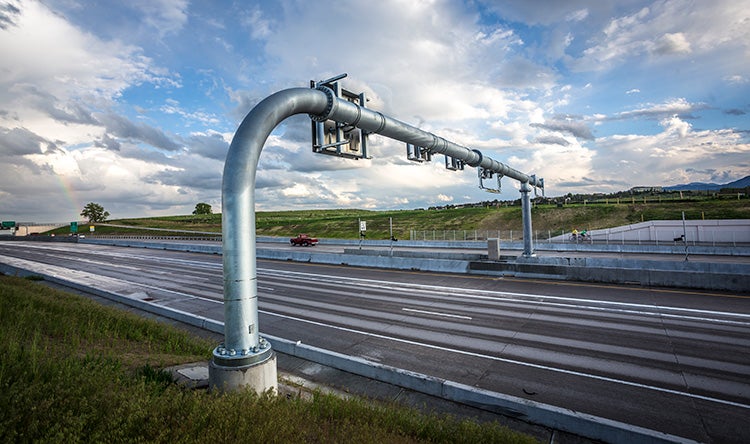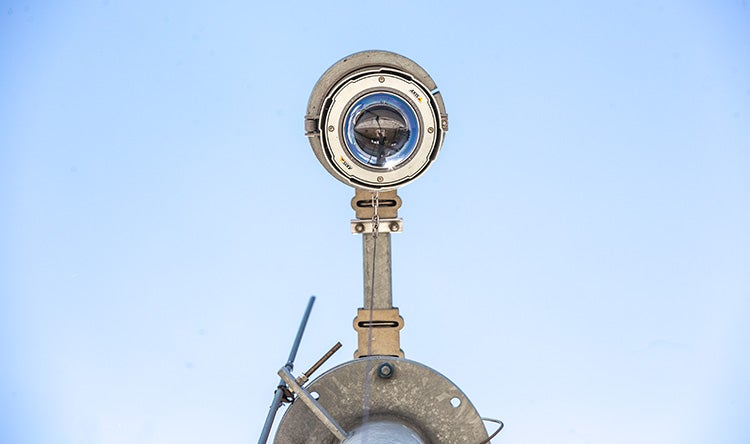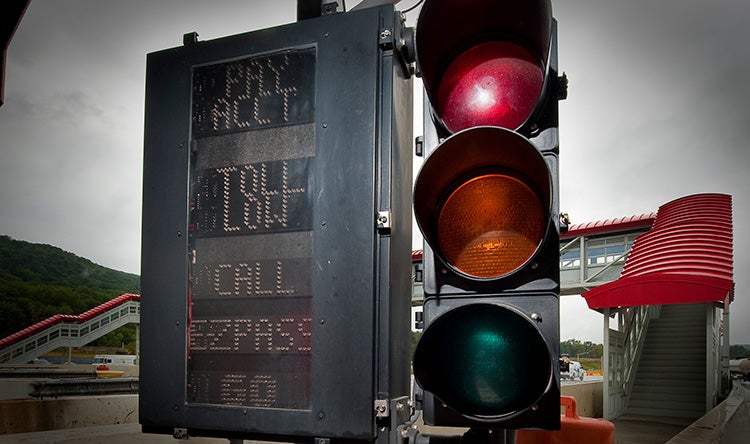
Experts Talk: Staying Up to Date on ITS with Joey Yang
Experts Talk is an interview series with technical leaders from across our transportation program.
Exploring the Benefits and the Future of Intelligent Transportation Systems
Transportation continues to advance, with modern technology keeping us safer, getting us to destinations more efficiently and causing less harm to the environment around us. Taking advantage of such advancements, however, requires first knowing about them and then being able to appropriately implement them.
Joey Yang is director of HDR’s transportation technology practice, which has a specialized focus on the development of intelligent transportation systems programs. He has been involved in designing and implementing transportation technology solutions for more than two decades, contributing to successful programs across the U.S., including the Gov. Mario M. Cuomo Bridge in New York, SR 520 Bridge Replacement and HOV Program in Washington state, Council Bluffs Interstate System in Iowa and many more.
In this interview, he shares some of the background of intelligent transportation and its benefits, as well as the ongoing trends and challenges in the industry. Finally, he lays out some of the steps that decision makers can take to enjoy the benefits of ITS.
Staying Up to Date on ITS
Q. What is ITS?
A. We all experience intelligent transportation systems every day. The term refers to the use of information and communication technologies to improve the way people and goods travel. Today, the most visual components of ITS are dynamic message boards that provide travel information to motorists. However, there is much more happening behind the scenes with roadside sensors, communications systems and equipment to make all of the components function correctly and seamlessly.
Today, ITS has evolved to become a holistic ecosystem that consists of various components including roads, roadside devices, operation centers, vehicles and the traveling public. By using technologies to exchange information among these components, this ecosystem enables the surface transportation system to provide smarter, safer and greener mobility services to its users.

Q. Why should transportation agencies, infrastructure owners and systems operators incorporate ITS into their projects?
A. By infusing technology into the roadside, vehicles and smartphones, we can get information to travelers faster, and we can better adapt the system to changing conditions. This leads to improvements in safety, mobility, efficiency and more. These strategies are also much less expensive to implement than physical roadside changes such as adding a lane or widening a roadway.
In my time at HDR, we’ve used ITS technology to enable some truly innovative solutions. For example, in the SR 520 floating bridge project in the Seattle area for Washington DOT we helped to implement a Smart Highways system. It uses a battery of ITS technologies collectively known as active traffic and demand management that uses overhead gantries, dynamic message boards and sensors to detect traffic conditions, automatically adjust speed limits and direct travelers to specific lanes. According to a WSDOT study, these ITS technologies helped reduce collisions by 4.1%, while other similar corridors without these technologies saw collision rates increase between 2.4% and 4.4%.
ITS solutions continue to evolve due to the ability to do more with less. This trend will likely accelerate as new types of technologies, including connected and automated vehicles, begin to come online. Transportation agencies have been in a lengthy battle with increasing traffic congestion in urban areas due to rapid population growth and the fast pace of urbanization. ITS technology will become even more important as agencies face continued funding constraints, in part due to shortfalls in gas tax revenue.
Q. How has ITS evolved and what is the state of the practice today?
A. In the 1960s through the early 1980s, vehicles became faster and more available to consumers. The number of vehicles on the road rose significantly, resulting in more vehicle miles traveled, and unfortunately resulting in more crashes and traffic fatalities. Computer systems were just being developed, and there was a natural evolution to using the new technology in transportation to help manage the increase in roadway usage.
Like many, I cut my teeth in traffic signals, helping to develop and deploy one of the most advanced traffic signal systems at the time in New York City. As we saw success with these early systems in improving safety and operations, it became increasingly obvious that ITS technology was here to stay.
Currently, the backbone of an ITS system is a series of networked computers that exchange information in real-time through fiber optic and wireless communications systems. As these systems have evolved, traffic engineers have evolved right alongside them. Today, we are designing ITS systems that integrate seamlessly with the roadway and provide travelers with information in milliseconds through dynamic message boards, overhead gantries, in-vehicle devices, smartphones and other systems. We are capturing real-time information on traffic using radar, Bluetooth and vision-based systems and linking them all together with a high-speed fiber or 5G communications network.

Q. What should we expect from ITS in the future?
A. As transportation technologies advance, the ITS ecosystem will grow multi-dimensionally at a faster pace than ever before. We will continue to see new developments in communications, vehicles and computing technology. Interactions between vehicles and users will vastly improve, as will vehicle automation.
Artificial intelligence, data analytics, edge/cloud computing and cybersecurity will continue to support the planning, development, operations and maintenance of transportation systems and keep gaining momentum as connected, automated, electric and shared vehicle technologies are widely deployed. Also, as personal computing advances, emerging technologies will make more personalized options available. A major part of integrating these types of technologies is the partnership that can be made with private-sector providers. New ways of conducting business are being developed between the public and private sectors that will result in a more efficient and effective system for users.
Recognizing and understanding these trends is important for agency leaders and infrastructure owners who hope to take advantage of the benefits this technology can provide, including improved safety, efficiency, mobility and more.
Q. How can transportation agencies, infrastructure owners and system operators best take advantage of ITS technology in the short-term?
A. Reviewing priorities is a good place to start. Operators should look at their list of projects and initiatives, and reprioritize their infrastructure investments if new technology and solutions make low-priority or postponed projects more cost-effective or feasible than previously assumed. Technology advancements can alter the needs of long-planned or ongoing projects, creating new requirements to keep them up to date.
For example, advancements in AI with predictive capabilities could soon lead to the automation of traffic management center operations. Performance-based and data-driven O&M programs can help manage assets like vehicle fleets more cost effectively than before. Infrastructure projects being designed and constructed today should include components needed for future automated and electric vehicles to minimize interruptions as they become more widely adopted.
Beyond smart planning, investments in cost-effective Transportation Systems Management and Operations solutions can improve the efficiency of existing infrastructure without adding traditional infrastructure. Alternative revenue generation strategies can also be rolled out, including variable road user fees and managed lanes.

Q. The technology is always changing, sometimes in unpredictable ways. How can we prepare for the long-term?
A. Agencies and system operators can advance technology research and education, ensuring their staff and the public are ready to embrace newer technology when it becomes feasible. Encouraging private sector involvement and promoting competition among technology providers can also accelerate innovation.
Coordination with policymakers is also key to breaking down the institutional barriers that hinder the deployment of recent technology. In some areas, for instance, only transit agencies are allowed to operate public passenger shuttles, which would make it impossible for a municipality to plan and test an AV shuttle deployment. In some areas, electronic tolling technologies are allowed only for toll collection but not for traffic management, which limit the options for agencies to deploy new technologies.
Inspiration and Advice
Q. What inspired you to focus your career in intelligent transportation systems?
A. I started my graduate study in transportation in the mid-1990s, when ITS was just beginning to develop. I realized that information and communication technologies played a critical role in ITS, and as a result, I continued with my master’s degree in computer science and telecommunications. As I earned my degree, I was involved in a few large-scale ITS projects that proved how essential ITS was for improving safety, efficiency and mobility.
Q. What advice would you offer to new professionals in the surface transportation industries who want to specialize in ITS?
A. ITS is a multidisciplinary field requiring a broad set of skills, including transportation systems; communications and control technologies; and electrical, computer, civil and traffic engineering. Younger professionals who would like to begin or advance their career in this field should:
- Be passionate about technology
- Have the desire to work with transportation systems and technologies as a life-long career
- Be willing to learn new things every day and eventually become an expert in one or multiple areas, including computer systems, communications and control technologies, automation, electrical power, and systems engineering.
- Be involved in professional organizations pertaining to ITS and transportation technologies, such ITS America, Institute of Electrical and Electronics Engineers, and Institute of Traffic Engineers
- Participate and present in regional and national technical conferences that promote ITS and emerging transportation technologies
Each Experts Talk interview illuminates a different aspect of transportation infrastructure planning, design and delivery. Check back regularly to see new insights from the specialized experts and thought leaders behind our award-winning, full service consulting practice.


